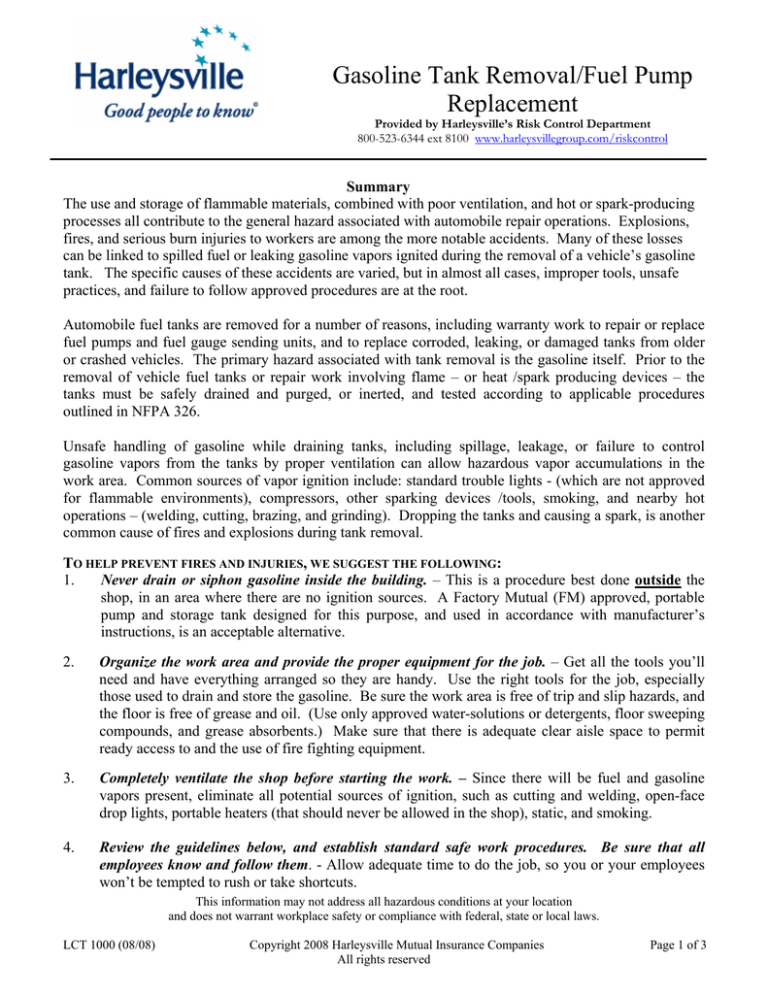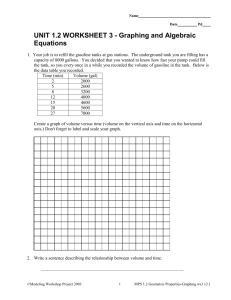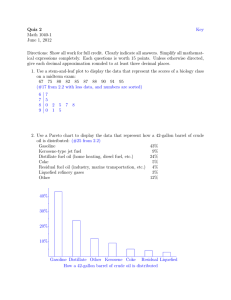Gasoline Tank Removal/Fuel Pump Replacement
advertisement

Gasoline Tank Removal/Fuel Pump Replacement Provided by Harleysville’s Risk Control Department 800-523-6344 ext 8100 www.harleysvillegroup.com/riskcontrol Summary The use and storage of flammable materials, combined with poor ventilation, and hot or spark-producing processes all contribute to the general hazard associated with automobile repair operations. Explosions, fires, and serious burn injuries to workers are among the more notable accidents. Many of these losses can be linked to spilled fuel or leaking gasoline vapors ignited during the removal of a vehicle’s gasoline tank. The specific causes of these accidents are varied, but in almost all cases, improper tools, unsafe practices, and failure to follow approved procedures are at the root. Automobile fuel tanks are removed for a number of reasons, including warranty work to repair or replace fuel pumps and fuel gauge sending units, and to replace corroded, leaking, or damaged tanks from older or crashed vehicles. The primary hazard associated with tank removal is the gasoline itself. Prior to the removal of vehicle fuel tanks or repair work involving flame – or heat /spark producing devices – the tanks must be safely drained and purged, or inerted, and tested according to applicable procedures outlined in NFPA 326. Unsafe handling of gasoline while draining tanks, including spillage, leakage, or failure to control gasoline vapors from the tanks by proper ventilation can allow hazardous vapor accumulations in the work area. Common sources of vapor ignition include: standard trouble lights - (which are not approved for flammable environments), compressors, other sparking devices /tools, smoking, and nearby hot operations – (welding, cutting, brazing, and grinding). Dropping the tanks and causing a spark, is another common cause of fires and explosions during tank removal. TO HELP PREVENT FIRES AND INJURIES, WE SUGGEST THE FOLLOWING: 1. Never drain or siphon gasoline inside the building. – This is a procedure best done outside the shop, in an area where there are no ignition sources. A Factory Mutual (FM) approved, portable pump and storage tank designed for this purpose, and used in accordance with manufacturer’s instructions, is an acceptable alternative. 2. Organize the work area and provide the proper equipment for the job. – Get all the tools you’ll need and have everything arranged so they are handy. Use the right tools for the job, especially those used to drain and store the gasoline. Be sure the work area is free of trip and slip hazards, and the floor is free of grease and oil. (Use only approved water-solutions or detergents, floor sweeping compounds, and grease absorbents.) Make sure that there is adequate clear aisle space to permit ready access to and the use of fire fighting equipment. 3. Completely ventilate the shop before starting the work. – Since there will be fuel and gasoline vapors present, eliminate all potential sources of ignition, such as cutting and welding, open-face drop lights, portable heaters (that should never be allowed in the shop), static, and smoking. 4. Review the guidelines below, and establish standard safe work procedures. Be sure that all employees know and follow them. - Allow adequate time to do the job, so you or your employees won’t be tempted to rush or take shortcuts. This information may not address all hazardous conditions at your location and does not warrant workplace safety or compliance with federal, state or local laws. LCT 1000 (08/08) Copyright 2008 Harleysville Mutual Insurance Companies All rights reserved Page 1 of 3 GASOLINE TANK REMOVAL PROCEDURES — INSIDE OF THE BUILDING. This work should only be performed in a manner using National Fire Protection Association Standard 30A, Section 9.7.5 – Code for Motor Fuel Dispensing Facilities and Repair Garages as a guideline. This standard allows the use of an approved portable pump and storage tank in lieu of draining the fuel tank outside the building. A standard safe work procedure should be developed and followed that includes – but is not limited to - the following: 1. The area where the gasoline tank is drained and removed from a vehicle must be adequately ventilated. Further, it must be isolated from activities and equipment that could cause an ignition of the vapors. 2. The vehicle battery should be disconnected. – (Disconnect the negative battery cable.) 3. A Factory Mutual (FM) approved gasoline removal device (pump and portable storage tank) should be obtained /used. - It should be used whenever gasoline is removed from vehicle tanks. The transfer of all gasoline should take place outside of the building. All fuel drained from a gasoline tank that is not to be disposed of should be stored in a UL-listed or FM approved safety can or returned to standard underground storage tanks. Fuel to be disposed of shall be stored in tanks or drums suitable for such purpose that are located outside the building until removed from the premises. Such containers should be identified /labeled as having flammable contents 4. Self-crimping radiator type clamps should seal all lines coming off of the tank. - This will help control gasoline drips and vapors coming out of the lines. 5. The tanks should be removed from the vehicle and then immediately taken outside of the building. 6. A fire extinguisher rated for gasoline fires (Class B) should be on hand and readily accessible. 7. In situations where the tank removal is done to facilitate fuel pump replacement, a non-sparking chisel and non-sparking hammer should be used to knock out the locking ring and remove the old fuel pump. The new fuel pump should then be installed. The fuel tank should be brought back into the building and re-installed in the vehicle. 6. The vehicle should be rolled out of the building and gasoline transferred back into the vehicle from the approved removal and storage device. Attached is an example of fuel transfer equipment that has received Factory Mutual approval. There are other brands of fuel transfer equipment available; this device is shown only as an example. Please note that all fuel transfer units must be used according to manufacturer instructions. This includes attaching the grounding wire that is provided. For additional information or assistance, please contact the Home Office Risk Control Central Services Division at 1-800-523-6344, Ext. 8100. This information may not address all hazardous conditions at your location and does not warrant workplace safety or compliance with federal, state or local laws. LCT 1000 (08/08) Copyright 2008 Harleysville Mutual Insurance Companies All rights reserved Page 2 of 3 Goodall© Gas•All Fuel Transfer Unit 53-526 ProTech Gas-All® Fuel Transfer and Storage Unit. Two way rotary pump for siphoning or dispensing. Works great for repairing today's hard to reach "in-tank" fuel pumps. Excellent for shops, car lots, salvage yards and rental outlets. The two wheel dolly design is easy to move. Meets OSHA & FM Standards. UPS/RPS Shipable. High quality, rebuildable pump. Flame arrestor neck/2" filler. 8' clear vinyl hose, 1/2" OD. Ground wire and clamp. 14 ga. welded steel, powder coated. Capacity: 25 gallons. Dimensions: Height 42", width 20", depth 22". Shipping weight: 85 lbs. Goodall Mfg. Co. 7558 Washington Ave. So. Eden Prairie, MN 55344 Call Toll Free 1-800-328-7730 Fax Tall Free 1-800-323-2617 www.goodallmfg.com Information presented here was obtained from Goodall Mfg. Co. and other sources. Harleysville Insurance Company does not recommend or endorse any specific products or manufacturers. This information is presented as an example of the type of product which should be used to safely and effectively remove fuel from gasoline tanks as part of an overall standard procedure for fuel tank work. There are numerous sources available on the Internet that provide detailed information on the removal of various automotive components. Many of these instructions are manufacturer and vehicle-specific and include procedures on how to relieve fuel system pressure and warnings about adjacent systems that could be affected in the tank removal. The specific manufacturer’s procedures should be consulted prior to performing this operation. Related Information: 1. What You Need To Know About …Auto Repair - [ http://autorepair.about.com/library/weekly/aa093000a.htm ] 2. Ontario Ministry of Labour – Alert: Gasoline Tank Removal [http://www.gov.on.ca/lab/ohs/i033.htm ] The information and suggestions contained in this data sheet have been developed from sources believed to be reliable. However, we accept no legal responsibility for the correctness or completeness of this material or its application to specific factual situations. This information may not address all hazardous conditions at your location and does not warrant workplace safety or compliance with federal, state or local laws. LCT 1000 (08/08) Copyright 2008 Harleysville Mutual Insurance Companies All rights reserved Page 3 of 3





